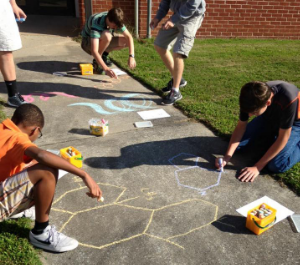
For example, in one of my recent teacher PD evaluation projects, we were unveiling a new learning strategy for students. One teacher in the group clearly wanted to cut to the chase—to know ahead of time what our observers were looking for in their planned classroom observations. This teacher’s request suggested that he was more focused on the outcome of classroom observations than on promoting student learning. Further illustrating this disconnect, I once worked with a chemistry professor, who, as he tried to overhaul his department’s lab curriculum, noted that many professors were reluctant to give students experiments that did not have predictable, known results. These two examples reflect what some teachers believe it means to be an effective teacher—that it requires knowing outcomes ahead of time and achieving predictable results in the classroom. In both cases, teacher identity was predicated on both the present and future conceptions of the self as a teacher—an amalgamation of how they viewed teachers when they were students, their own training and experience, and the demands, feedback, and expectations from others.
Apart from instilling a concept of teacher identity in pre-service teachers, how can we foster success of teachers who are in the day-to-day of the typical teaching environment of student management, the call for personalized learning, and testing? As we encourage students to be life-long learners, shouldn’t we also encourage teachers to be open to learning throughout their teaching careers? Life-long learning facilitates openness to new ideas and new ways of conveying concepts to their students.

My former high school AP biology teacher, Emily Sassano, experienced a major teacher identity shift in her fifth year of teaching. “In my first couple years,” she says, “I focused my energy and attention on making sure that I, the teacher, was knowledgeable about my content and knew how to present it to students. However, I learned rather quickly that the ‘old school’ methodology of me simply giving students the information they needed to know about my content wasn’t interesting or relevant. It was outright boring.”
Avoiding an identity crisis
How do we help more teachers make an identity shift like Emily if they’re not already aware of the need? For those who are, how do we make PD more relevant? Teachers are more likely to be successful in changing their practices when PD is delivered in such a way that they can see a connection between the strategy being taught and what is important to them as teachers. They become confident in their ability to accomplish the steps and be successful with the strategies, even in potentially difficult situations. PD typically tries to give teachers the confidence for using the strategies, but it does not always tackle the relevance to teachers—who they are now and what they want to be—or provide strategies for persisting through difficulties because the goal is important. PD delivery could benefit from adding these two components to truly transform teaching and help teachers avoid a later identity crisis.
For Emily, self-reflection led to an awakening of her new teacher identity. “That’s when I started stepping out on a limb and releasing some of my direction and control to the students,” she says. She began offering students multiple options for their lab work. “Instead of just doling out ‘cookie cutter’ style recipes for labs, I let students decide what variables they wanted to test and then come up with actions for testing them. They seemed to become more active in this endeavor and [it] gave them more ownership for their learning.”
As Emily describes it, her teacher identity shifted from “director” to “facilitator of learning.” Now 20 years into her teaching career, both Emily and her students have reaped the benefits. “I wake up each day excited about coming to school and thrilled for them to find out what new and fun things we’re going to do together each day to learn biology,” she says. Clearly, positive student- and teacher-identities both contribute to academic success in Emily’s classroom.
But, what about students? Does a student’s self-identity also play a part in classroom motivation? I’ll explore that a bit more in a follow-up post next week.



I agree that a teacher’s self-identity has a huge impact on his or her classroom and students. It also effects how much they gain from professional development.
I completely agree with what you said about teachers being encouraged to continuously learn. It only makes sense since we as teacher encourage and teach our own students how to be life long learners. Students tend to get bored fairly quickly so having teachers open to new ideas ultimately enhances student learning in multiple ways. I also agree that professional development could benefit from adding tackling relevance to teachers and provide strategies to deal with difficulties faced. Adding those two components would benefit teachers in endless ways. It would also boost confidence of a lot more teachers and their ability to fight through the tough times.
Thank you both for your comments, Breana and Jessica. We’d love to hear more from you about a time when your identity as a teacher was taken into account in PD if that is something you’ve experienced.
In Eastern Carver County Schools (Chaska, Chanhassen, Victoria and Carver, MN) our teacher union (Chaska Education Association) offers access to Courage to Teach retreats (educator cohorts work individually, in small groups and as a community to reconnect soul and role) and Leading Together practices (courage work in the schools to build relational trust). Your conversation – regarding the identity of the teacher – is countercultural. And we need a lot more of it!